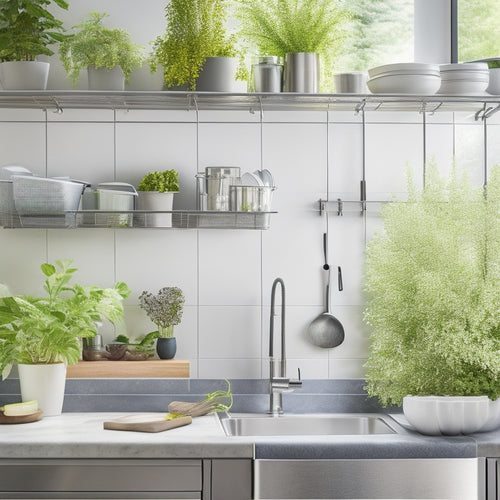
Design Your Dream Home With Personal Style
Share
Designing a dream home is a deeply personal endeavor that requires a thoughtful blend of aesthetics, functionality, and individuality, where every element, from color palettes to lighting fixtures, is a reflection of one's unique style and personality. From interior accessories that add texture and depth to furniture selection that provides comfort and defines a room's purpose, every detail matters. As you set out on this journey, consider how your personal style can guide every aesthetic and functional decision, creating a symphony of purpose and beauty. Now, uncover the secrets to bringing your vision to life, where every detail forms a cohesive whole.
Key Takeaways
• Define your personal style by selecting a color palette that evokes emotions and sets the tone for your dream home.
• Balance functionality with aesthetics by choosing furniture that provides comfort and defines each room's purpose.
• Customize details such as unique fixtures, hardware, and cabinetry to reflect your personal style and maximize storage.
• Incorporate natural elements to bring the outdoors in and create a cohesive look that reflects your personal touch.
• Ensure every design element, from lighting to textures, works together to create a symphony of purpose and beauty.
Unleashing Your Personal Style
As you set off on the journey of designing your dream home, your personal style serves as the foundation, guiding every aesthetic and functional decision to create a truly bespoke space that reflects your unique character and personality.
Your color palettes, carefully curated to evoke emotions and set the tone, are expertly paired with interior accessories that add texture and depth.
Thoughtful furniture selection not only provides comfort but also defines the room's purpose, while strategic lighting fixtures enhance ambiance and functionality.
Designing for Function and Form
By harmoniously balancing aesthetics and practicality, functional design elements seamlessly merge with visually stunning forms to create a symphony of purpose and beauty in your dream home.
When designing for function and form, functionality first is key. This means considering the flow of your daily routine and how each space will be used. By doing so, you can create areas that are both beautiful and functional.
Balancing aesthetics with practical considerations ensures that your home is not only visually appealing but also safe and efficient. A well-designed home should facilitate easy movement, provide ample storage, and incorporate smart solutions that cater to your unique needs.
Bringing Your Vision to Life
With a clear vision of your dream home in mind, the next step is to transform your ideas into a tangible reality, where every detail, from the texture of the walls to the color of the cabinets, comes together to form a cohesive and breathtaking whole.
To bring your vision to life, focus on customizing details that reflect your personal style, such as:
-
Unique fixtures and hardware that add a touch of elegance to your space.
-
Custom cabinetry that maximizes storage and functionality.
-
Incorporating natural elements, like reclaimed wood or living walls, to bring the outdoors in.
Frequently Asked Questions
How Do I Balance Personal Style With Resale Value Considerations?
As a master painter applies the finishing strokes to a Renaissance masterpiece, so too must homeowners strike a delicate balance between injecting personal style and preserving resale value, cleverly incorporating customization options that tantalize without alienating future buyers.
Can I Reuse Existing Fixtures and Materials in My New Design?
When renovating, consider upcycling fixtures and revamping materials to reduce waste and costs. Salvaging elements from the original structure can be creatively redesigned into new spaces, ensuring a sustainable and budget-friendly approach while maintaining design integrity.
What Is the Average Timeframe for a Custom Design Project?
The average timeframe for a custom design project typically ranges from 3-12 months, depending on project scope and complexity, with potential project delays mitigated by effective budget management and clear communication.
Are There Any Specific Certifications for Custom Home Designers?
Custom home designers may hold certifications like NCARB, AIA, or NAHB, demonstrating expertise in design considerations that enhance resale value, ensuring a safe and functional living space that meets individual needs and exceeds expectations.
Can I Make Changes to the Design Plan After Construction Begins?
During construction, change requests can lead to costly delays and potential safety hazards. It is crucial to thoroughly review and finalize the design plan before breaking ground to avoid construction delays and guarantee a smooth, safe building process.
Related Posts
-

Wall-Mounted Dish Drainer Racks for Kitchens
Wall-mounted dish drainer racks are a game changer for your kitchen. They maximize vertical space, freeing up preciou...
-

Ceiling-Mounted Pot Racks for Professional Chefs
Ceiling-mounted pot racks are revolutionary for professional chefs like you. They make use of vertical space, keeping...
-

Stackable Kitchen Containers for Dry Goods
Stackable kitchen containers are perfect for organizing dry goods and maximizing your kitchen space. They help reduce...


